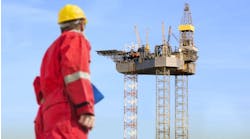Simulator improves understanding of forces acting on subsea equipment
Nick Terdre
Contributing Editor
Marintek – the Norwegian Marine Tech- nology Research Institute – has developed a simulator with a range of deep-water applications such as modeling installation of subsea structures and the behavior of spar platforms. The institute's deepwater expertise, including the new simulator, will be further extended during a three-year research program now under way.
The simulator builds on two key programs for the dynamic analysis of marine units and operations developed by Marintek, which is itself part of the Sintef group of research institutes. These are:
- Simulation of Marine Operations (SIMO), a program for simulating complex, multi-body marine operations
- RIFLEX, an element program for analysis of risers and other flexible components.
Since 2000, the institute has been striving to improve its understanding of, and calculation methods for, marine operations in general and deepwater operations in particular, says Principal Research Engineer Peter Christian Sandvik. The simulator, which was delivered in October last year, resulted from both improvements to SIMO's ability to analyze different kinds of precision operations and the incorporation of a high-quality visualization program.
The development marks a significant advance in the ability to predict and control dynamic conditions during deepwater operations such as installing, inspecting and intervening in subsea equipment. Such a capability is necessary for production to be safely and efficiently carried out in depths of 3,000 m or more, Sandvik says.
Riser replacement
The simulator has been used in the preparation of a number of riser replacement operations in conventional water depths on the Norwegian continental shelf. It makes it possible to analyze the risk of collision between the new and existing risers and to identify the limit of weather and sea conditions in which the operation can be safely carried out. The first such riser replacement was performed late last year on Norsk Hydro's Njord field in 330 m of water.
Hydro also commissioned the use of the tool in the Fram West development, both for the installation of two subsea templates in 360 m water depth, and for the installation of a 950-ton process module on the Troll C floating production platform. The latter operation caused a 6° tilt as the module was landed in one corner of the platform, with about 8 m of winch wire being paid out as the platform tilted down and the crane-barge up.
(Above) Marintek's marine operations simulator can be used to analyze operations such as riser replacement and (below) lifting a heavy module onto a floating platform.
Using a combination of the simulator and model tests, it was possible to test aspects of the installation operation such as what the winch speed should be, scenarios such as unexpected motions just prior to landing, and the likelihood of missing the guide points. Running the operation through the simulator also played an important role in familiarizing the crews of the platform and the crane-barge with the operation and assuring the platform crew that, despite the large tilt, everything was under control, Sandvik says.
Hydrodynamic analysis
Another objective of the simulator development was to establish hydrodynamic data for partly ventilated subsea structures such as protection covers with vents. The data for these and other structures consisting of parallel tubulars is inadequate and in some cases unreliable. This is an important gap to fill, especially because the use of such structures is becoming more common, and also because their passage through the wave zone often represents the critical stage of an installation operation. Following a survey of existing data and the performance of model tests to supplement existing data, it is now possible to provide improved documentation for such installation operations.
A slender element model has been implemented in SIMO for calculating the forces acting on structures such as spoolpieces during installation, including the passage through the splash zone. The model has also proved useful for the analysis of non-linear spar dynamics and the dynamics of structures built from slender elements, such as jackets. It enables a better description of wave behavior and the motions of a spar hull, which could provide the basis for design improvements to the hull and mooring system.
Surface operations
A number of new features have been implemented in SIMO that permit the dynamic analysis of various surface operations and improve the accuracy of calculations. One example is hydrodynamic coupling, the way two or more nearby vessels affect each other's motions due to effects on the hydrodynamic pressure field around their hulls. Such proximity effects can usefully contribute to analyzing operations such as the side-by-side transfer of cargo from one ship to another, and the heavy-lift installation by a floating crane of a module onto a floating platform.
For the installation of subsea equipment in deepwater, a catenary element model of the lift-wire that is capable of dealing with the variation of current in space and time has been implemented.
Research program
The issue of currents is a central theme in a three-year research program on deepwater operations that Marintek is now undertaking, with funding from the Research Council of Norway. Hydro and Statoil also support the program, worth an annual NKr2-3 million. The institute has identified currents as a key concern, as the experience from deepwater operations indicates important gaps in present knowledge. Currently a static design current is used in analyzing such operations, which results in a conservative estimate of extreme loads and offset and fails to identify operational problems arising from current variability. Alternative models capable of describing deepwater currents will be studied.





